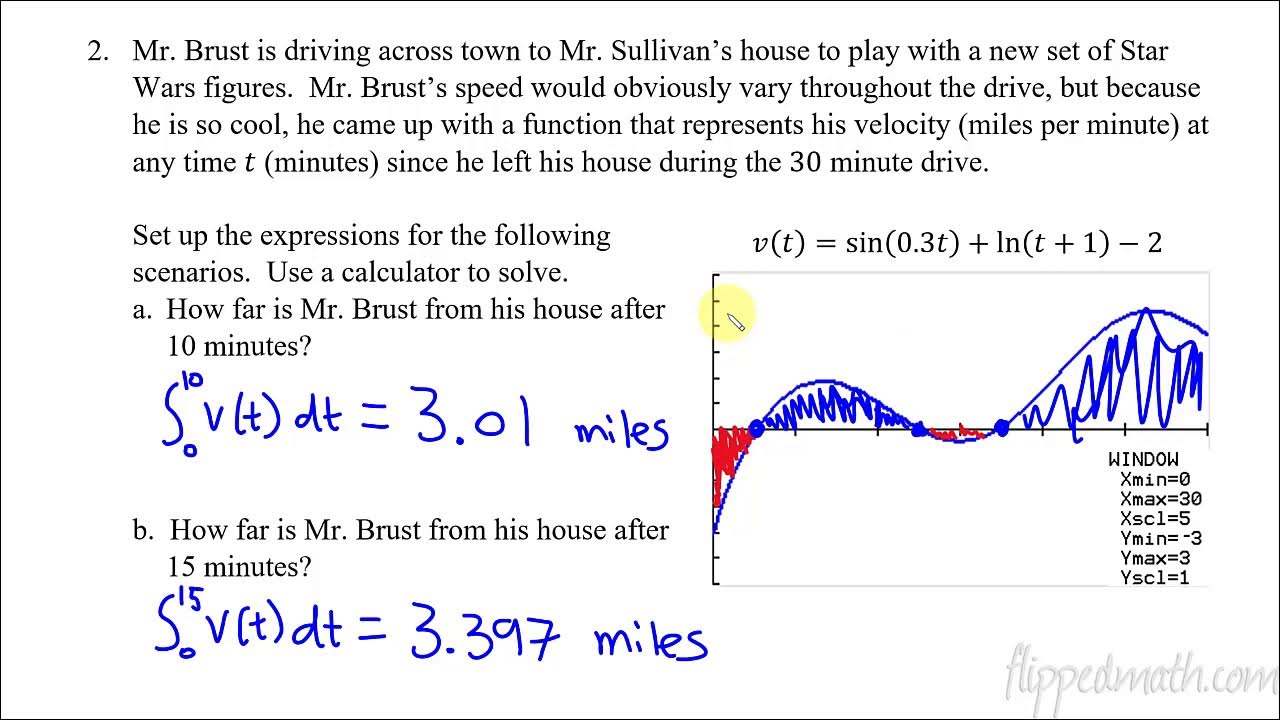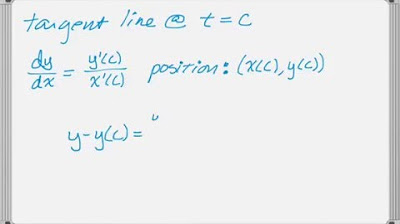AP Calculus BC Lesson 9.6
TLDRIn this lesson, the application of parametric equations and vector-valued functions to particle motion within the context of the AP Calculus exam is explored. Key formulas for velocity, acceleration, speed, displacement, and arc length are reviewed. The video delves into solving problems involving finding velocity and acceleration vectors, determining when a particle is at rest, calculating the total distance traveled, and identifying specific points on the particle's path. The use of derivatives and integrals is emphasized in solving these problems, with a focus on understanding the mathematical concepts and their practical applications.
Takeaways
- 📚 The lesson focuses on applying parametric equations and vector-valued functions to particle motion problems in the context of the AP Calculus exam.
- 🌟 Velocity is the first derivative of position and acceleration is the second derivative of position, with speed represented as the square root of the sum of the squares of the rate of change of position components.
- 📈 Displacement between two times is given by the integral of velocity from the initial to the final time, while arc length is the integral of the speed over time.
- 🎯 To find the new position, integrate the velocity from the initial time to the desired time and add it to the initial position.
- 🚫 A particle is at rest when both its x and y rate of change components (dx/dt and dy/dt) are zero.
- 🔄 The position of a particle in the XY plane is given by parametric equations, and the velocity vector can be obtained by differentiating these equations.
- 🕒 Specific problems in the lesson involve calculating the velocity vector at a given time, the acceleration vector, determining when a particle is at rest, and finding the total distance traveled.
- 📊 The script provides examples of how to set up and solve for various particle motion scenarios using calculus concepts and integrals.
- 🛤️ Arc length is calculated using the integral of the speed, which is derived from the square root of the sum of the squares of the derivatives of the position functions.
- 📌 The script emphasizes the importance of understanding the context of particle motion and the application of vector calculus to solve problems on the AP Calculus exam.
- 📝 The lesson concludes with a calculator-free response question that tests the understanding of the concepts taught, including finding the velocity vector, acceleration vector, speed, and the time at which certain conditions are met for a particle in motion.
Q & A
What is the main focus of Lesson 9.6 in the video?
-The main focus of Lesson 9.6 is to apply knowledge of parametric equations and vector-valued functions to the context of particle motion on the AP Calculus exam.
How is velocity related to position in particle motion?
-Velocity is the derivative of position, representing the rate of change of position with respect to time.
What is the formula for calculating the speed of a particle at any time T?
-The speed of a particle at any time T can be represented by the square root of (x'(t)^2 + y'(t)^2), where x'(t) and y'(t) are the derivatives of the x and y components of the position vector, respectively.
How is displacement from time T1 to T2 represented in the context of particle motion?
-Displacement from time T1 to T2 is represented by the integral from T1 to T2 of the velocity vector V(t) dt.
What is the significance of arc length in the context of particle motion?
-Arc length represents the total distance traveled by the particle and is calculated as the integral from time T1 to T2 of the square root of (dx/dt)^2 + (dy/dt)^2 dt.
How can you find the velocity vector of a particle at a specific time T, given its position vector?
-To find the velocity vector at a specific time T, you take the derivative of the position vector with respect to time.
What is the acceleration vector of a particle, and how is it related to the velocity vector?
-The acceleration vector is the derivative of the velocity vector, which can also be thought of as the second derivative of the position vector with respect to time.
How can you determine if a particle is at rest at a certain time?
-A particle is at rest if both its x and y components of velocity (dx/dt and dy/dt) are equal to zero at a certain time.
What is the relationship between the total distance traveled and the speed of a particle?
-The total distance traveled is found by integrating the speed (the magnitude of the velocity vector) over a time interval, without the need for absolute value signs since the square root ensures non-negativity.
How do you calculate the distance of a particle from the origin at a specific time, given its position vector?
-To calculate the distance from the origin, you find the x and y components of the position vector at the specific time, then use the Pythagorean theorem to find the hypotenuse of the right triangle formed by these components.
What is the significance of finding the tangent line's slope at a specific point on a particle's path?
-Finding the slope of the tangent line at a specific point gives insight into the direction and steepness of the path at that particular location, which can be used to analyze the motion characteristics of the particle.
Outlines
📚 Lesson 9.6: Parametric Equations and Vector-Valued Functions in Motion
This paragraph introduces Lesson 9.6, focusing on applying parametric equations and vector-valued functions to the context of particle motion in the AP Calculus exam. It emphasizes the importance of understanding how velocity and acceleration are derived from position functions and how to calculate speed, displacement, and arc length. The lesson also covers the concept of a particle being at rest and provides a method for solving problems involving these concepts.
🚀 Calculating Velocity and Acceleration Vectors
The paragraph delves into the calculation of velocity and acceleration vectors for a particle moving in the XY plane. It explains how to find the velocity vector by differentiating the position vector and how to calculate the acceleration vector by differentiating the velocity vector. The paragraph includes specific examples with given parametric equations and demonstrates the process of finding the velocity and acceleration at particular times.
🧭 Determining Rest and Motion States
This section focuses on identifying when a particle is at rest by setting the derivatives of position (DX/DT and DY/DT) to zero. It provides a method for finding the times when a particle is not moving by solving these equations. The paragraph also explains how to determine the point at which a particle is at rest by evaluating the position functions at the times found.
📏 Measuring Distance and Speed
The paragraph discusses how to calculate the distance of a particle from the origin at a given time and the total distance traveled between two times. It explains the process of integrating the velocity vector to find the arc length and how to use the Pythagorean theorem to find the distance from the origin. Additionally, it covers how to find the speed of a particle at a specific time by taking the square root of the sum of the squared derivatives of the position functions.
🔍 Analyzing Tangent Slope and Arc Length
This paragraph addresses the calculation of the slope of the tangent line to the particle's path and the determination of the total distance traveled. It provides a method for finding the time at which the slope of the tangent line is equal to a given value by setting up and solving equations involving the derivatives of the position functions. The paragraph also explains how to calculate the arc length of the particle's path over a specified time interval.
Mindmap
Keywords
💡Parametric Equations
💡Vector-Valued Functions
💡Velocity
💡Acceleration
💡Speed
💡Displacement
💡Arc Length
💡Derivative
💡Integral
💡Particle Motion
Highlights
The lesson focuses on applying parametric equations and vector-valued functions to particle motion in the context of the AP Calc exam.
Velocity is the derivative of position and acceleration is the second derivative of position.
The speed of a particle at any time T can be represented by the square root of the sum of the squares of its derivatives with respect to time.
Displacement from time T1 to T2 is given by the integral of the velocity vector from T1 to T2.
Arc length, representing total distance traveled, is calculated as the integral of the speed from T1 to T2.
When a particle is at rest, its derivatives DX/DT and DY/DT are both equal to zero.
To find the new position, integrate the velocity vector from the initial time to the desired time.
The velocity vector of a particle moving in the XY plane is given by the derivative of its position vector.
The acceleration vector is found by taking the derivative of the velocity vector.
A particle is at rest at the time when both its x and y derivatives are zero.
The total distance traveled by a particle is found using the arc length formula.
The distance of a particle from the origin is calculated using the Pythagorean theorem.
The slope of the tangent line to a particle's path is given by the ratio of the derivatives of the position vector components.
The speed of a particle is calculated using the magnitude of the velocity vector.
The time at which a particle's path has a specific slope can be found by setting the ratio of derivatives equal to the desired slope and solving for time.
The total distance traveled by a particle along a curve is found using the arc length formula applied to the parametric equations of the curve.
The x coordinate of a particle's position at a given time is found by integrating its x component from a known initial time to the desired time.
The time at which a particle has a specific speed is found by setting the magnitude of the velocity vector equal to the desired speed and solving for time.
The time at which the slope of the tangent line to a particle's path is a specific value is found by setting the ratio of the derivatives of the position vector components equal to that value and solving for time.
Transcripts
Browse More Related Video

Calculus AB/BC – 8.2 Connecting Position, Velocity, and Acceleration of Functions Using Integrals

Equations of Motion

2022 Live Review 6 | AP Calculus BC | Working with Parametric Equations and Vectors

2023 AP Calculus BC Free Response Question #2

Polar, Parametric, Vector Multiple Choice Practice for Calc BC (Part 1)

AP Calculus BC Parametric and Vector AP Exam Review
5.0 / 5 (0 votes)
Thanks for rating: